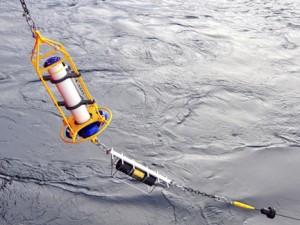
Click to enlarge
The Arctic mooring contains a full suite of biogeochemical sensors, including CO2 and has been used to monitor ocean acidification in the Alaskan Arctic. (Photo: Natalie Monacci, Ocean Acidification Research Center)
Scientists estimate that that the ocean is 25% more acidic today than it was 300 years ago, traceable to increasing levels of atmospheric CO2 from fossil fuel combustion and land use change. The ocean absorbs almost half of the anthropogenic CO2, which increases its acidity.
Alaska waters are especially susceptible because of their unique circulation patterns and colder temperatures—cold water can absorb more CO2 than warm water.
Better understanding how the ocean absorbs CO2 and other gases will help scientists and managers prepare Alaskans for potential impacts to fisheries and livelihoods. To that end, AOOS is committed to working with a coalition of partners to fund, deploy and maintain buoys and moorings that monitor ocean pH.
Frequently Asked Questions on ocean acidification
Consequences in the Arctic
- Bering Sea crab, pollock and halibut fisheries may suffer from the potential loss of prey as calcifying organisms disappear.
- While there are currently no commercial fisheries in the Arctic Ocean, the region will likely serve as a bellwether for future OA conditions further to the south, and can provide valuable insights into the future of the Bering Sea and Gulf of Alaska.
AOOS aids monitoring effort
The Arctic mooring was deployed in October 2011 with a full suite of biogeochemical sensors. It will be recovered in October 2012 and will provide a full year’s record of CO2 and other parameters.
This mooring joins two buoys deployed near Resurrection Bay and in the eastern Bering Sea. Sensor data are recorded hourly and streamed to UAF and NOAA-PMEL, and—in the future—to AOOS.
